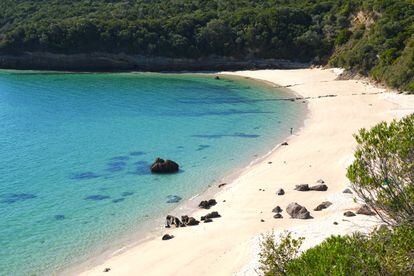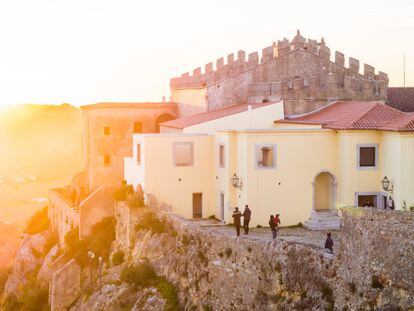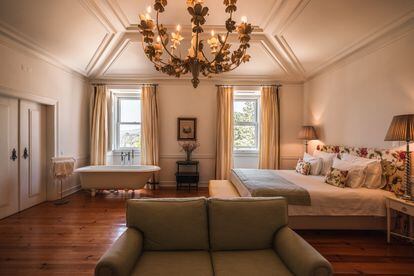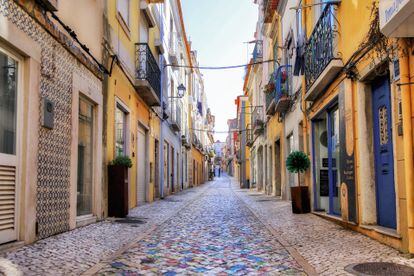Winter 1963. An elegant-looking, fragile and prematurely aged woman drives through the green heart of the Arrábida natural park, about 50 kilometers south of Lisbon. At only 34 years old, she has crossed the Atlantic Ocean fleeing an unimaginable tragedy: the murder of her husband. Jacqueline Kennedy seeks refuge. A hiding place away from the press and the weight of the history that has made her the most famous widow of the 20th century. When 60 years have passed since that desperate escape, we crossed in a Jeep the same hills through which the widow traveled in her Portuguese retreat. In the distance you can see the Palácio de Comenda, property of the Counts D'Armand, the friends who opened their five-story, 26-room residence so that Jackie could find, precisely, what the word “arrabida” means in its Arabic origin: a place of recollection and prayer.
During her isolation, Jackie walks among cork oaks, pine forests and vineyards. Walk along a secluded beach (although his palace has one with private access) and travel along the road that winds through the natural park, dotted with noble houses that remind us that this was one of the summer resorts of European royalty, like the descendants of the Irish O'Neill dynasty. From the top of the mountain range, Jackie sees the Castelo de São Jorge in Lisbon, the Castelo dos Mouros in Sintra and the Castelo de Évora, three strategic fortifications for centuries in the defense of Portugal. On the days of greatest recollection, he approaches the immaculate white village that stands out among the greenish mass: the Monastery of Our Lady of Arrábidafounded in 1542 by the Franciscans.
As then for Jackie Kennedy, the Arrábida mountain range continues today to be a privileged refuge in the middle of nature. However, it is hardly known by international and even local travelers. How is it possible?
In search of an answer, during our trip we met an illustrious neighbor of the region, Salvador Holstein, descendant of María Luisa and Bernardo Sousa Holstein, dukes of Palmela. Holstein explains that competition from the nearby city of Comporta has eclipsed interest in this other area, much less crowded, despite its proximity to the Portuguese capital. It will be he who, as they did with Kennedy six decades ago, will take us into these 10,000 hectares nestled between the Sado River and the Atlantic, in a perfect triangle delimited by the municipalities of Setúbal, Azeitão and Palmela.

Mediterranean green, Atlantic blue
The path between cliffs through Portinho da Arrábida leaves aside one of the most diverse sets of Mediterranean flora and fauna in the country. On the opposite side, a winding road, with narrow ascents and descents, looks towards the beaches where bathers enjoy, in the hottest months, accompanied by a community of around thirty bottlenose dolphins. From above, it's easy to understand why this last stretch of Portugal's pristine coastline has sparked Sandra Ortega's real estate ambitions. The first-born daughter of Amancio Ortega, creator of Inditex, wants to build a luxury hotel complex with more than 500 beds here, on the Tróia peninsula. The environmental platform Dunas Livres has managed to paralyze for the moment the project, which would multiply the number of tourists in the tongue of dunes formed next to the mouth of the Sado River.
Meanwhile, the Arrábida remains a relatively unknown place. A paradise of nature and sandy beaches along 40 kilometers, from Tróia to Melides. For the modest price of the ticket charged by a small boat, for example, you can enjoy beaches like Galapinhos almost alone. This sandy area was chosen as the most beautiful beach in Europe, among 280 other European beaches, in a vote in which more than 130 countries participated. Nearby are also the beaches of Albarquel, Figueirinha, Galapos, Conejos, Creiro, Portinho da Arrábida and Alpertuche. They are all a luxury available to anyone.

Route between towns
As we descend through Portinho da Arrábida, Salvador Holstein's car takes us to the part near the sea, where the best restaurants in the area are located, such as Lantern, which serves fresh fish with views of the sea, or Galeão, whose menu allows you to savor the best of local cuisine along with the wines of this region covered in vineyards for centuries. From here are those of José Maria da Fonseca, the oldest table winery in the country (1834), those of Quinta da Bacalh
oa or those of Quinta de Alcube, another of the most genuine in the area.
Advancing through vineyards to the east of the mountain range you reach the Palmela castle, 240 meters above sea level, a fortification of Muslim origin, between the 8th and 9th centuries, which is today a national monument. From its tower it is easy to see Lisbon on clear days. Next to it, the Gothic church of Santiago de Palmela, from the 15th century, and an old convent that is today a pousadafrom the network of Pousadas de Portugal, in the style of the Spanish Paradores.

The descent from the castle allows you to take a route through some of the most picturesque towns in the area, such as Azeitão, at the foot of the mountains, where the artisanal sheep queijo or the fresh requijão. A walk through its cobbled streets also allows you to enjoy inexhaustible traditional pastries or visit the São Simão-Arte tile factory, one of the last producers of artisanal tiles in Europe. Here they patiently explain the entire manufacturing process, from baking to painting. Brush in hand, its artisans give life to the tiles that decorate buildings inside and outside of Portugal. If the traveler gains their trust, they may end up revealing the whims of Elton John by decorating their bathroom with these Portuguese tiles. It is one of the few entertainments in the town, in addition to the Harvest Festival or the medieval Saints Festival.

Casa Palmela, the heart of the park
Back at the natural park we arrive at Palmela House, the Holstein estate, whose 70 hectares have remained in his family for two centuries. It is one of the few private properties within this natural area, where construction has been prohibited since 1975. A 17th century manor house, classified as an Asset of Municipal Interest, today converted into a 21-room hotel, surrounded by forest and vineyards of syrah and muscat grapes. Casa Palmela served as a summer residence for the São Francisco Xavier Jesuit College of Setúbal and today preserves part of the four-century-old stone floor, original furniture, 18th century tiles and a small chapel.

Behind closed doors, the room where the Jesuits once had lunch is today a restaurant with a terrace that serves clams bulhão duckcod cakes with tomato or the typical picapau. From the outside, the views from the accommodation encourage you to take a walk through the mountains, on foot or on horseback, on a route that crosses paths and vineyards.

From here it is easy to organize boat trips, sunset yoga classes or excursions to the cheese factories in nearby towns or to the Mercado do Livramento de Setúbal, which supplies Casa Palmela and where every day is a coming and going among its 900 employees. Early risers looking for fresh fish and travelers who want to get up close and personal with this fishing and agricultural market, inaugurated in 1876, and which USA Today recognized in 2015 as one of the best in the world. Once they have taken the obligatory photograph next to the large mural of 5,700 tiles that tells the life of fishermen and farmers, the travelers leave the market. Local life continues in this Portuguese paradise, far from mass tourism.

Subscribe here to The Traveler newsletter and find inspiration for your next trips in our accounts Facebook, x and instagram.
#Arrábida #inexplicably #unknown #paradise #Portugal